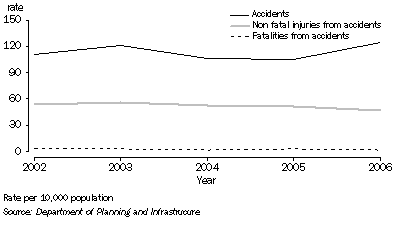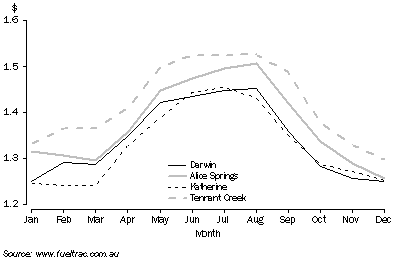|

|
TRANSPORT |
Transport remains a topic of importance for the Northern Territory due to its large land area and isolated population centres.
In 2006 road traffic accidents in the Northern Territory occurred at a rate of 105 per 10 000 population. In the same year, fatalities from road traffic accidents occurred at a rate of 2 per 10 000 population and non fatal injuries at a rate of 47 per 10 000 population. Males were 2.8 times more likely to be involved in fatal accidents and 1.6 times more likely to be involved in non-fatal accidents than females. Drivers of motor vehicles and passengers in motor vehicles accounted for 78.4% of those injured in road traffic accidents. Pedestrians and pedal cyclists accounted for 11.3% of those injured in traffic accidents. Collisions between moving vehicles accounted for 46.5% of accidents, while vehicle roll overs and vehicles that ran off the road accounted for 30.3% of accidents.
Rate of accidents and Injuries, Northern Territory
: 2002-2006

There was a large variation in accident rates across regions. For example, the highest road traffic accident rate of 227 per 10 000 population was observed in the Finniss region, which also had the highest non-fatal injury rate of 158 per 10 000 population. The lowest motor vehicle accident rate was observed at Bathurst-Melville (31 per 10 000 population) and also lowest non fatal injury rate (20 per 10 000 population). The Alligator region was the only Statistical Subdivision to have had no road fatalities in 2006.
Injuries resulting from road traffic accidents generally occurred at a higher rate in more remote regions than the urban regions of Darwin City and Palmerston-East Arm. For example Daly and Barkly have rates of non fatal injuries caused by road traffic accidents of 68 and 83 injuries per 10 000 population respectively, whilst Darwin City and Palmerston-East Arm have rates of 40 and 28 injuries per 10 000 population respectively.
In contrast the number of accidents involving multiple vehicles is higher in the urbanised regions than remoter regions. In Darwin City accidents involving collisions and striking a parked vehicle totalled 75% of all accidents. In the Litchfield region this figure was 50% and in Lower Top End NT it was 25%.
In 2006 the majority of road users injured in road traffic accidents were drivers ( 52%), 26% of road users injured in accidents were passengers and 10% motor cyclists.
In 2006 monthly average unleaded fuel prices were generally highest in Tennant Creek, followed by Alice Springs, then Darwin and Katherine at similar levels. During the year average prices in the Northern Territory peaked at $1.52 in August in Tennant Creek and bottomed in February in Katherine at $1.24.
Average Unleaded Fuel Prices: 2006

Further information on transport in the Northern Territory can be obtained from the following sources:
Department of Planning and Infrastructure
Motor Vehicle Census, Australia (cat.no. 9309.0)
Sales of New Motor Vehicles,Australia (cat.no. 9314.0)
Fueltrac
 Print Page
Print Page
 Print All
Print All